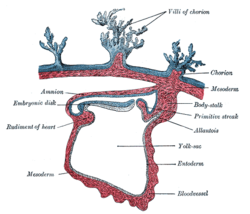Epiblast
| Epiblast | |
|---|---|

Section through the embryo. (Epiblast visible but not labeled.)
|
|
| Details | |
| Carnegie stage | 3 |
| Days | 8 |
| Precursor | inner cell mass |
| Gives rise to | ectoderm, mesoderm, endoderm |
| Identifiers | |
| Latin | epiblastus |
| Code | TE E5.0.2.2.1.0.1 |
|
Anatomical terminology
[]
|
|
In amniote animal embryology, the epiblast is one of two distinct layers arising from the inner cell mass in the mammalian or from the blastodisc in reptiles and birds. It derives the embryo proper through its differentiation into the three primary germ layers, ectoderm, mesoderm and endoderm, during gastrulation. The amnionic ectoderm and extraembryonic mesoderm also originate from the epiblast.
In mammalian embryogenesis, differentiation and segregation of cells composing the inner cell mass of the blastocyst yields two distinct layers—the epiblast ("primitive ectoderm") and the hypoblast ("primitive endoderm"). While the cuboidal hypoblast cells delaminate ventrally, away from the embryonic pole, to line the , the remaining cells of the inner cell mass, situated between the hypoblast and the polar trophoblast, become the epiblast and comprise columnar cells.
Upon commencement of gastrulation, the primitive streak, a visible, morphological groove, appears on the posterior epiblast and orients along the anterior-posterior embryo axis. Initiated by signals from the underlying hypoblast, formation of the primitive streak is predicated on epiblast cell migration, mediated by Nodal, from the lateral-posterior regions of the epiblast to the center midline. The primitive knot is situated at the anterior end of the primitive streak and serves as the organizer for gastrulation, determining epiblast cell fate by inducing the differentiation of migrating epiblast cells during gastrulation.
...
Wikipedia
